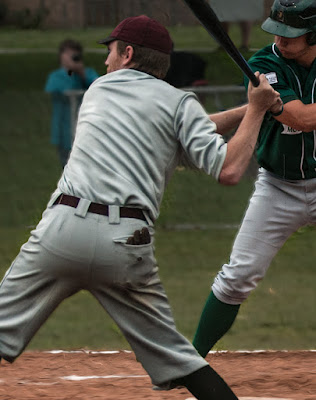 Okay, so Scott Kelby didn't single me out and teach me this
technique. I saw him discuss it on one
of his Photoshop based shows. Probably
on Photoshop User TV. His demonstration
involved using Curves to sculpt a model's face.
I watched, tucked in away in the back of my mind and thought I might be
able to use it for other "stuff".
Okay, so Scott Kelby didn't single me out and teach me this
technique. I saw him discuss it on one
of his Photoshop based shows. Probably
on Photoshop User TV. His demonstration
involved using Curves to sculpt a model's face.
I watched, tucked in away in the back of my mind and thought I might be
able to use it for other "stuff".
Today's image is an example of an "other stuff" application. Scott showed that by using Curves to increase
the depth of the shadows and increase the heights of the highlights you could
use the tones inherent in the image to add drama. I took it and applied it to the folds and
creases of the batter's shirt and pants.
It's really quite simple (and pretty foolproof). Set up two Curves Adjustments Layers. Tag one as Shadows and the other
Highlights. In the Shadows Curve bring
the upper right end of the linear Curve (straight line) to the left until you
just touch the edge of wherever the tone Curve ends. Eyeball a point on the Curve about three
quarters of the way "up" the straight line. Drag it up so the Curve is now steep and almost
to the top of the box. Invert the Mask
that goes with the Adjustment Layer. The
Mask should now be black.
Do just the opposite to the curve tagged as Highlights. Bring the right side of the linear Curve to
the tip of wherever the tone Curve ends.
About one quarter in from the left side of the Curve, drag the Curve
down to brighten the image. Invert that
Mask to black.
Make the Foreground color White. Select the Brush Tool (B). Make it hard, at least 95% hard. Make it small. Depending on the resolution of the image,
somewhere around 3 to 6.
Click on the Mask named Shadows. Everywhere you see a shadow line, paint a
line all the way down the shadow. Click
on the Mask named Highlights. Everywhere
you see a highlight, paint a line all
the way down the highlight. As a hint,
where's a highlight next to every shadow.
You'll see that, even though you painted the shadow with a white paint
brush, every shadow becomes darker. Not
only does it become darker, but it gets darker by different amounts. In the areas with lighter shadows you'll see
"less dark" lines. In the
areas of darker shadows you'll see "darker" lines. Same (just the opposite) goes for the
highlights. (One hint, highlights and
shadows never cross. They should be parallel
to each other.)
Now you'll have all these lines all over your image. In Adobe Photoshop CS6 you have a Properties
dialog box that goes along with each Adjustment Layer. Open it.
Move the Feather Slider to the right.
Keep an eye on your Shadow (or Highlights) and watch them spread out and
become soft. You can go as far as you
feel is necessary. At some point it will
become too soft and you won't see the effect.
The idea is to emphasize the differences by putting a
highlight next to a shadow. It becomes
rather Rockwellesque (Norman Rockwell like) and makes the details jump out of
the frame.





0 comments:
Post a Comment